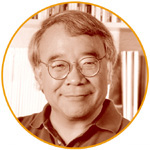
Website: http://yamamotolab.ucsf.edu Email: Yamamoto@ / ucsf, edu
600 16th Street, MC 2280Genentech Hall, Room S572DSan Francisco, CA 94143
Phone: 415- 476-8445
Executive AssistantAngela Gross415 476-8445angela.gross / ucsf, edu
We study the activity of the intracellular receptors (IRs), including receptors for glucocorticoids (GR), androgens (AR) and thyroid hormone (TR), in signal transduction and transcriptional control. These hormone-receptor complexes bind to specific DNA sequences termed hormone response elements, which enhance or repress linked promoters.
Our goal is to understand the molecular and cellular logic by which IRs integrate multiple signaling inputs to produce specific, distinct and coherentresponses.
We have defined IR domains for hormone and DNA binding, dimerization, nuclear localization, phosphorylation, interaction with various cellular factors and transcriptional regulation. IRs functions faithfully when expressed in simpler organisms such as yeast and Drosophila, thus facilitating genetic analyses of their actions and identification of other factors involved in its activities. Studies of IRs in C. elegans permit analyses of developmental and physiologic control by these factors in an experimentally accessible metazoan.
We are also pursuing 3D structure analyses of various domains of the receptor, and we employ biochemical strategies with purified components for mechanistic analyses. Thus, using genetic, structural, molecular and biochemical approaches, we use IRs as “biological probes” to define how a single regulatory protein can specify diverse patterns of specific gene expression in different cellular contexts.
These reductionist strategies can increasingly be applied to studies of complex physiological and pathological processes. For example, we are pursuing: (a) a signaling “crosstalk” pathway in developing T-cells in which activation of the T-cell receptor abrogates glucocorticoid-induced apoptosis; (b) dramatic shifts in AR activity and ligand responses during prostate cancer ontogeny and progression; (c) the consequences of glutamine repeat expansion in AR, leading to motor neuron degeneration in spinal and bulbar muscular atrophy.